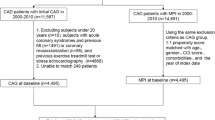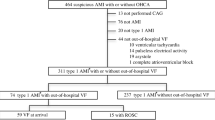Abstract
The aims of the present study are to: (1) clarify the angiographic follow-up (AFU) rate after discharge; (2) elucidate the characteristics of those undergoing it; and (3) determine the impact of AFU on subsequent revascularization procedures among patients with acute myocardial infarction (AMI). Three thousand and twenty-one consecutive patients presenting within 48 h of AMI onset were enrolled from 17 centers in Japan between January 1999 and June 2001. To clarify the frequency of AFU and their characteristics, 2736 patients who survived at discharge were analyzed. Among 1160 patients matched by propensity score, the impact of AFU on subsequent revascularization was analyzed. Of 2736 patients, 1367 (50%) underwent AFU and constituted the lower-risk population. Of the 580 matched patient pairs, 120 (21%) in the clinical follow-up group and 198 (34%) in the AFU group underwent subsequent revascularization (hazard ratio 7.54; 95% confidence interval 5.74–9.91). Of the 198 patients in the AFU group, 157 (79%) underwent revascularization at the discretion of the responsible physician based on angiographic findings. Angiographic follow-up led to more subsequent revascularization. More evidence would be necessary to determine the effectiveness and the methods by which patients are selected.
Similar content being viewed by others
References
Tomaru T, Fujimori Y, Nakamura F, Aoki N, Sakamoto Y, Kawai K, Omata M, Uchida Y (1996) Induction of thrombolysis and prevention of thrombus formation by local drug delivery with a double-occlusion balloon catheter. Heart Vessels 11:123–132
Grines CL, Browne KF, Marco J, Rothbaum D, Stone GW, O’Keefe J, Overlie P, Donohue B, Chelliah N, Timmis GC, Vlietstra RE, Strzelecki M, Puchrowicz-Ochocki S, O’Neill WW (1993) A comparison of immediate angioplasty with thrombolytic therapy for acute myocardial infarction. The Primary Angioplasty in Myocardial Infarction Study Group. N Engl J Med 328: 673–679
Watanabe I, Nagao K, Tani S, Masuda N, Yahata T, Ohguchi S, Kanmatsuse K, Kushiro T (2006) Reperfusion strategy for acute myocardial infarction in elderly patients aged 75 to 80 years. Heart Vessels 21:236–241
Grines CL, Cox DA, Stone GW, Garcia E, Mattos LA, Giambartolomei A, Brodie BR, Madonna O, Eijgelshoven M, Lansky AJ, O’Neill WW, Morice MC (1999) Coronary angioplasty with or without stent implantation for acute myocardial infarction. Stent Primary Angioplasty in Myocardial Infarction Study Group. N Engl J Med 341:1949–1956
Nobuyoshi M, Kimura T, Nosaka H, Mioka S, Ueno K, Yokoi H, Hamasaki N, Horiuchi H, Ohishi H (1988) Restenosis after successful percutaneous transluminal coronary angioplasty: serial angiographic follow-up of 229 patients. J Am Coll Cardiol 12:616–623
Serruys PW, van Hout B, Bonnier H, Legrand V, Garcia E, Macaya C, Sousa E, van der Giessen W, Colombo A, Seabra-Gomes R, Kiemeneij F, Ruygrok P, Ormiston J, Emanuelsson H, Fajadet J, Haude M, Klugmann S, Morel MA (1998) Randomised comparison of implantation of heparin-coated stents with balloon angioplasty in selected patients with coronary artery disease (Benestent II). Lancet 352:673–681
ten Berg JM, Kelder JC, Suttorp MJ, Verheugt FW, Thijs Plokker HW (2001) Influence of planned six-month follow-up angiography on late outcome after percutaneous coronary intervention: a randomized study. J Am Coll Cardiol 38:1061–1069
Kasanuki H, Honda T, Haze K, Sumiyoshi T, Horie T, Yagi M, Yamaguchi J, Ishii Y, Fujii SY, Nagashima M, Okada H, Koganei H, Koyanagi R, Tsurumi Y, Kimura H, Ogawa H (2005) A largescale prospective cohort study on the current status of therapeutic modalities for acute myocardial infarction in Japan: rationale and initial results of the HIJAMI Registry. Am Heart J 150:411–418
Rubin DB, Thomas N (1996) Matching using estimated propensity scores: relating theory to practice. Biometrics 52:249–264
SAS Institute Inc (1999) SAS/STAT user’s guide, version 8. SAS Institute Inc., Cary, NC, pp. 2622–2628
Kurotobi T, Sato H, Kinjo K, Nakatani D, Mizuno H, Shimizu M, Imai K, Hirayama A, Kodama K, Hori M (2004) Reduced collateral circulation to the infarct-related artery in elderly patients with acute myocardial infarction. J Am Coll Cardiol 44:28–34
Khaykin Y, Austin PC, Tu JV, Alter DA (2002) Utilisation of coronary angiography after acute myocardial infarction in Ontario over time: have referral patterns changed? Heart 88:460–466
Woods KL, Ketley D, Agusti A, Hagn C, Kala R, Karatzas NB, Leizorowicz A, Reikvam A, Schilling J, Seabra-Gomes R, Vasiliauskas D, Wilhelmsen L (1998) Use of coronary angiography and revascularization procedures following acute myocardial infarction. A European perspective. Eur Heart J 19:1348–1354
Ayanian JZ, Landrum MB, Normand SL, Guadagnoli E, McNeil BJ (1998) Rating the appropriateness of coronary angiography-do practicing physicians agree with an expert panel and with each other? N Engl J Med 338:1896–1904
Tu JV, Naylor CD, Pashos CL, McNeil BJ (1998) Coronary angiography and revascularization after acute myocardial infarction: which rate is right? Eur Heart J 19:529–530
Stukel TA, Fisher ES, Wennberg DE, Alter DA, Gottlieb DJ, Vermeulen MJ (2007) Analysis of observational studies in the presence of treatment selection bias: effects of invasive cardiac management on AMI survival using propensity score and instrumental variable methods. JAMA 297:278–285
Alter DA, Naylor CD, Austin PC, Chan BT, Tu JV (2003) Geography and service supply do not explain socioeconomic gradients in angiography use after acute myocardial infarction. CMAJ 168: 261–264
Alter DA, Ko DT, Newman A, Tu JV (2006) Factors explaining the under-use of reperfusion therapy among ideal patients with ST-segment elevation myocardial infarction. Eur Heart J 27:1539–1549
Rupprecht HJ, Espinola-Klein C, Erbel R, Nafe B, Brennecke R, Dietz U, Meyer J (1998) Impact of routine angiographic follow-up after angioplasty. Am Heart J 136:613–619
Shah BR, Laupacis A, Hux JE, Austin PC (2005) Propensity score methods gave similar results to traditional regression modeling in observational studies: a systematic review. J Clin Epidemiol 58:550–559
Sturmer T, Joshi M, Glynn RJ, Avorn J, Rothman KJ, Schneeweiss S (2006) A review of the application of propensity score methods yielded increasing use, advantages in specific settings, but not substantially different estimates compared with conventional multivariable methods. J Clin Epidemiol 59:437–447
Ragosta M, Camarano G, Kaul S, Powers ER, Sarembock IJ, Gimple LW (1994) Microvascular integrity indicates myocellular viability in patients with recent myocardial infarction. New insights using myocardial contrast echocardiography. Circulation 89:2562–2569
Natarajan MK, Gafni A, Yusuf S (2005) Determining optimal population rates of cardiac catheterization: a phantom alternative? CMAJ 173:49–52
Alter DA, Stukel TA, Newman A (2006) Proliferation of cardiac technology in Canada: a challenge to the sustainability of Medicare. Circulation 113:380–387
Graham MM, Ghali WA, Faris PD, Galbraith PD, Tu JV, Norris CM, Zentner A, Knudtson ML (2005) Population rates of cardiac catheterization and yield of high-risk coronary artery disease. CMAJ 173:35–39
Author information
Authors and Affiliations
Corresponding author
Rights and permissions
About this article
Cite this article
Shimada, K., Kasanuki, H., Hagiwara, N. et al. Routine coronary angiographic follow-up and subsequent revascularization in patients with acute myocardial infarction. Heart Vessels 23, 383–389 (2008). https://doi.org/10.1007/s00380-008-1060-y
Received:
Accepted:
Published:
Issue Date:
DOI: https://doi.org/10.1007/s00380-008-1060-y




